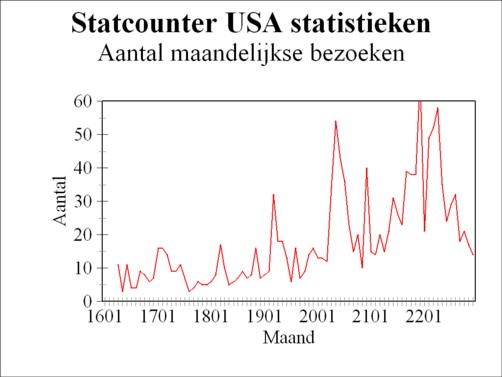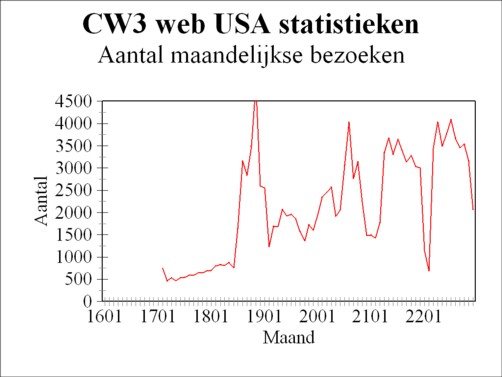
Figure 1: Number of monthly visits
according to Statcounter
The Highlights is the weblog of Emil Bakkum (the Netherlands), who initiated this project. He got stuck on political economics as a science, and reads all kinds of professional literature about this theme, in the widest sense. Fortunately, self-study is free from external limitations, such as the partitioning of scientific disciplines, and bridging them sometimes produces surprising insights. The Highlights wants to make this knowledge accessible to those, who also feel passion for political economics. The contributions must be considered as personal notes, without external supervision, and thus with a chance of sloppiness and mistakes. As far as the readers are hurt by then, that remains their personal responsibility.
In 2012 the Highlights appeared for the first time on the worldwide web, in Dutch. Until april 21, 2014 the portal was called Heterodox Gezelschap Sam de Wolff. At the start the studies focused on theories of a social-democratic origin. The term "gezelschap" (association) in the title wants to express, that other lovers of heterodox economics could in principle contribute texts for publishing on the portal. That was a hopeless ambition. After a few years she was abandoned, and on april 21, 2014 the name was replaced by the present one: Heterodoxe Gazet Sam de Wolff.
In 2012 the portal was still suspicious with regard to the theoretical building, that is known as the neoclassical paradigm. Much leftwing literature argued, that this paradigm is advanced by powerful rightwing groups. Because of this the portal focussed notably on heterodox models. Since 2015 it became clear, that the heterodox theory is not a true alternative for the neoclassical paradigm. Besides, the neoclassical paradigm has found interesting imitations in the sociology and psychology. This contributed to the credibility of the neoclassical models, who nowadays take into account the influence of the human nature on the social activities. Recently, the game theory, behavioural economics, happiness economics, and especially new institutional economics (NIE) have become popular. The NIE applies various methods from the neoclassical theory, and therefore is a promising synthesis. She forms a bridge between the neoclassical and heterodox paradigms.
In 2015 the social-democratic policies did still receive special attention. This was not very fruitful, because she experiences an ideological crisis since the eighties, and searches for a new identity. In 2016 a similar project was executed for the christian-democracy. Here it became clear, that this movement also searches for a new profile. Since then, the Highlights has distanced itself from political activism, and the attention turned to scientific theories from economics, sociology and public management. The heterodoxy of the Highlights is now expressed mainly by a preference for interdisciplinary arguments. Now and then this are still referrals to the political blogs of the past, which give a personal charm and unique image to the Highlights (or so your blogger hopes).
Thus since 2017 the Highlights tries to join the common and recent opinions about political economics. The contents moves towards comparisons and comments concerning theories, models, arguments and data sets. The contributions become increasingly relevant for the practical implementation of policies. Thanks to the independent reports the Highlights provides a unique standard for interested students and policy advisors.
Since 2016 the older blogs are translated in English (again without external supervision), and placed on the subsidiary Highlights website in California.
Nowadays the blogs excel by their wide orientation, which does not hesitate to use triangulation and mixed methods. They try to do justice to all perspectives and thus sketch the most objective picture of reality. Although this interdisciplinary approach can reveal the existing controversies, it is yet controversial itself. Moreover, the wide orientation hurts the depth of analysis. This all gives cause for (more) modesty. Therefore in 2022 your blogger has changed the name of the portal into Holland grumpy De Wolff. Besides, it is easier to remember this name.
In 2023 there was an increased awareness, that grumpy does not do justice to the scientific contents of the blogs. Therefore now the name Highlights Genre De Wolff has been preferred. The blogs are memories of the knowledge, which has been acquired by self-study, and disgested and presented in the style of Sam de Wolff.
The portal is named after the Dutch scientist Sam de Wolff (1878-1960), because he is one of the greatest heterodox economists that our country has known. His pioneering work remains an inspiration for anybody, who outside the beaten tracks searches for ways to describe the economic actions. The banner, that decorates the head of the start page, is composed of pictures from the front frieze of the Haus des Lehrers in Berlin, made by Walter Womacka. Dictatures can create attractive façades.
The initiator and editor of the Highlights Genre De Wolff is Emil Bakkum. He is professionally active in the Sociaal Consultatiekantoor, where he holds the position of solicitor and blogger. The publication of essays about the political economy, also on an academic level, are part of his mission.
The domain is hosted bij CW3 Hosting. The design of the site is not by CW3 Hosting.
Your blogger feels encouraged, when sympathizers help to increase the fame of the Highlights. The effect of such efforts will show in the following statistics. The Statcounter index counts the number of monthly visits to the main page. The CW3 (AWStat) index counts the number of monthly visits to the Highlights as a whole. An alternate CW3 index is obtained from Webalizer. The horizontal axis uses the notation year-month.


